Peter MALONE
Saturday, 18 September 2021 19:19
Man from the Deep River, The/ El Paese Del Sesso Selvaggio
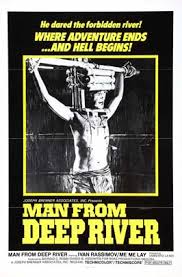
EL PAESE DEL SESSO SELVAGGIO (THE MAN FROM THE DEEP RIVER)
Italy, 1972, 93 minutes, Colour.
Ivan Rassimov, Me Me Lai.
Directed by Umberto Lenzi.
The Man from the Deep River also has the original title The Village of Savage Sex. It is considered the first of the Italian cannibal sub-genre. Lenzi was to return to this later with such films as Eaten Alive, also starring Rassimov.
The film was made in Thailand, and is a delight for sadist audiences. A photographer in the rain forest is captured by the locals, lives with them, marries the chief’s daughter, protects them from an attack by a cannibal tribe.
This was the period of Mondo Carne, a pseudo-documentary of the 1960s (which had the very popular song ‘More’) which had its directors moving around the world to find as many gory and unpleasant situations as they could find. There seemed to be an appetite for this kind of film in the late 60s and during the 1970s.
Umberto Lenzi made over sixty films during his forty years as a director, most of them genre films, historical adventures as well as adaptations of comic book style novels. This is a curio item – not for everyone.
1. Could this film be called enjoyable? Interesting? How attractive, how repelling? How exploitive? Was it a good film?
2. For what audiences was the film made? For what types of interest? Anthropology, interest in the exotic, cruelty and sadistic?
3. Was it a good adventure film? A hero lost in the jungles, accommodating himself to jungle life and its incidents? Or was it something more? A type of Robinson Crusoe in the jungle? Therefore the incidents being important factors in the hero's changing? Which interpretation is more plausible? Why?
4. How important was the clash of civilisations? The world of planes, dating, the boxing, bars and knifings, photography? The difference with the barbarity of the villages leading to community acceptance? What happened to Bradley during his stay?
5. How important were the documentary overtones of the film? The initial statement about its truth, life in Thailand, life along the Burmese boarder? The questions of ancient and barbaric civilisations? The documentary aspects of the community life of the peoples? The quality of life, cruelty, initiations, sexuality, marriage, war, building up the community in its physical sense as well as its moral sense?
6. Was the film too sensational and exploitive? The amount of bloodletting, torture, ugliness of the eating of food, decapitation of the monkey, the cannibals etc? Or was it valuable to visualise these? Audience response to them?
7. The contrast of the village with the cannibals? The murder, the hacking of the arm, the eating of the arm, the fighting? Audience response to the villagers when they were confronted by the cannibals?
8. How did the film gain interest and fascination? What does the seeing of this kind of way of life do to an audience?
9. Was Bradley an interesting character? The background of his way of life, his professionalism in his photography? His capacity for surviving, his hostility, the effect of torture and endurance? His fighting the men and his becoming a hero? Love as changing his attitudes? The possibility of a family? His escaping for Maria's sake? His final decision to stay?
10. How attractive heroine was Maria? In contrast with the barbarity around her? The effect of the witch-doctor on her? Her growing love for Bradley, their playfulness, the contrast with the hard life? Her blindness, the escape, the birth, her death? Audience response to Maria, and finally in her death?
11. How conventional was the portrayal of the chief? His listening to the men and the warriors? His change of attitude towards Bradley?
12. How conventional and successful were the sequences with the witch doctor and his melodrama? The melodrama of his death?
13. How conventional also was the good woman? The fact that she could speak English, her helping of Bradley, her helping him go to escape, the severing of her hand?
14. Why did Bradley decide not to return? The symbol of the helicopter throughout the film? what values did this film stand for? What values was it promoting? With what integrity? what values did it presuppose in its audience?
Published in Movie Reviews
Published in
Movie Reviews
Tagged under
Saturday, 18 September 2021 19:19
Man in the Glass Booth, The
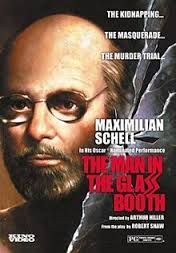
THE MAN IN THE GLASS BOOTH
US, 1975, 117 minutes, Colour.
Maximilian Schell, Lois Nettleton, Lawrence Pressman, Luther Adler, Lloyd Bochner.
Directed by Arthur Hiller.
The Man in the Glass Booth was a presentation of the American Film Theatre, a project of the mid-1970s which filmed a number of prominent plays including Brecht’s Galileo, Ionesco’s Rhinoceros, John Osborne’s Luther. This film was based on a play by Robert Shaw (the actor best known for such films as Jaws and The Sting). Allegedly, he was not happy with the final film version and asked for his name to be removed from the credits.
Maximilian Schell gives a very strong performance as the proprietor of a financial empire, which he rules from his apartment in Manhattan. However, it appears that he is a war criminal in hiding. After his arrest, an accusation that he was Adolf Dorff rather than Arthur Goldman, having taken on the name of a victim of the concentration camp, he is judged and, for safety’s sake, kept in a glass booth. (The plot has echoes of the capture and trial of Adolf Eichmann.
The film has a character actor cast including Luther Adler (who had portrayed Hitler in the past) as the presiding judge.
The film was directed by veteran Arthur Hiller, best known for Love Story and for comedies like Silver Streak.
This is a very intellectual film as well as emotional, reminding audiences of the reality of the Holocaust, of the Jewish victims of the concentration camps, of the ruthlessness of the Nazi officials.
1. How successful a transferral to the screen of a stage play? The limitations of its scenes, especially in the second part, in the court?
2. The strength of the dialogue from the play, the quality of the speeches and their transferring to the screen, especially the confrontations of Goldman in the court case? Where did the strengths of the play lie? What were the strengths of the film?
3. How much did the film depend on audience response to the Jews, their fate during the way, Nazis and their cruelty? the of the concentration camps, modern Israel and its rights for war criminals?
4. Audience response to Arthur Goldman? The possibility of identifying with him? Or observing him? How mad did he seem in the first part, the puzzle of his way of life, the puzzle of his arrest? the ironies of his trial? Sympathy and antipathy? The impact of the truth about his identity? And the need for the reconsideration for all that we had seen him do and say?
5. How mad a person was Goldman? His playing with his own identity and that of Dorf? His feelings Of guilt of having survived the concentration camp when so many died? His taking on guilt freely? willing his suffering, and yet being a victim? The Christian religious overtones of his speech? Signs of the cross, Latin prayers, the illusion to the pope and the forgiveness of the Jews by the Council? The Christ figure solution in understanding him? Christ as a Jew who took on the sufferings of the world? Was considered mad? The Christ-figure aspects for an anti-violent solution to the problems and hostilities of the modern world?
6. The initial picture of Goldman trying hard to be an American, his language, his emphases, his erratic behaviour, talk? The gist of his talk about America and himself? His pre-War experience? His dependence upon Charlie and his use of him? Of the doctor?
7. The hidden life of Goldman? His fears, burns, his wife's memorial, the pope's forgiveness, the money? All to be reinterpreted in the later light of the truth?
8. The impact of the car following him, his arrangements about x-rays, the drama of the arrest, the indignity of the search? His immediate acting polite to the Nazi, bring suffering on himself, his defiance, and his mad mouthing of the extremist statements and attitudes?
9. Goldman's experience in the prison in Israel? The indignity and his calling world attention to himself? His confrontation with Mrs Rosen? (In the later light oft her outburst about Israel's aggressiveness and the need for attacking first in the modern world?), his attitudes towards Mrs Rossen, his vulgarity in her regard, his showing off and exhibitionism? His deal about his illegal entry, his wearing the Nazi uniform? His assertiveness? All to reinterpreted in the light of the ending?
10. The significance of the visitor, the doctor, the discussion about individual psychosis, the psychosis of a nation,# what was normal, and mass guilt when a nation is in error?
11. The significance of the glass booth? Dorf and his uniform, the court and the people there, the judges and their presuppositions, the chief judge and his hearing of the case, the audience and their weeping during the trial, their aggression against the Nazi atrocities?
12. Mrs Rossen and her initial speech for emotion, the world press, the legality of the trial, the appeal to the moral law? The legality of the abduction and the arrest? Dorf's reactions to these? how much truth was spoken in his acts? The calling of the witnesses and their stories? The accumulated detail of these atrocities and its impact on audiences? The value of remembering these years later? The witnesses and their identifying of Dorf?
13. The significance in detail of Dorf's reactions to the witnesses? His callous attitudes, his applause? The dramatic significance of the main outburst speech, with his imitations of Hitler, the Nazi music and singing, the expression by an individual of the German pride in Nazism, the admiration and love for Hitler? The ambiguities of his speech about love and hate? How well could an audience understand fanaticism, and the response to Hitler via this speech? The technique that he used to communicate this understanding?
14. The surprise of the interviews with the doctors, the truth about their substituting the x-rays for money, fulfilling Goldman's punishment?
15. The impact of the truth? Mrs Rossen being taken aback, the sympathy of the judge? The audience reaction? The fact that Derf was not Dorf, but Goldman? The question of guilt and identification for guilt and punishment? The significance of his imagined death? The Christ figure, stance that Goldman took? The message of the suffering and non violence for a violent world?
16. The significance of remembering these 20th century themes for the present day?
Published in Movie Reviews
Published in
Movie Reviews
Tagged under
Saturday, 18 September 2021 19:19
Man in the Iron Mask, The/ 1977
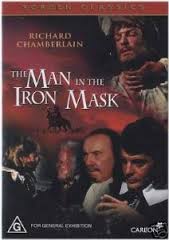
THE MAN IN THE IRON MASK
US, 1977, 100 minutes, Colour.
Richard Chamberlain, Patrick Mc Goohan, Louis Jourdan, Jenny Agutter, Ian Holm, Ralph Richardson, Vivien Merchant, Brenda Bruce, Esmond Knight, Godfrey Quigley, Denis Lawson, Hugh Fraser.
Directed by Mike Newell.
This version of The Man in the Iron Mask was made for television. It is spectacular in its presentation – though subjugated to the limits of television production. It also has a star cast with Richard Chamberlain acting as Louis XIV and his twin brother Philippe. Patrick McGoohan? is the adviser to the king. Louis Jourdan is D'Artagnan and the film presents the three and four Musketeers in their old age. The strong supporting cast includes Jenny Agutter, Ian Holm and Ralph Richardson as the adviser to the king, Colbert.
The film is more of a surface version, focusing on characters and action, rather than an exploration of themes and characters in depth.
It was directed by Mike Newell who began his career in British television in the early 1960s, directing such programs as Coronation Street. He moved into making films in 1980, including the New Zealand film, Bad Blood. From the 80s onwards he made a number of significant films including Dance With A Stranger, The Good Father, Enchanted April, Four Weddings and a Funeral, Pushing Tin, Mona Lisa Smile, Harry Potter and the Goblet of Fire and Love in the Time of Cholera.
1. The popularity of this classic story? The cinema tradition? the classic of the thirties? The continued popularity of Alexandre Dumas' work? History, costume action melodrama? The value of a cinema remake?
2. Audience response to history, action, politics, intrigue?
3. The production values: French location photography, decor, buildings, musical score, the cast?
4. The plausibility of the plot: imagination about French history, Dumas' writing and his interpretation of events, sensationalising them? Life at the Court of Louis XIV? Intrigue, French national identity, crises? The historical judgments on Louis XIV? The plausibility of twins and the substitution of the king? Dumas' themes of mistaken identity, concealment, prison, escape, vengeance? The romantic background of such stories?
5. The ironies of the title - Philippe and his imprisonment, his release, Louis XIV becoming the prisoner? The focus on the mask, its being forged in the fire, its being put on Philippe? D'Artagnan and his use of it to elude Fouqet? The finale with Louis in the mask?
6. Louis XIV and his image at the opening of the film: fop, tantrums, playing games, his attitudes towards his mother, rudeness towards his wife, the infatuation with Louise, his relationship with women in the court? The scenes alone with Louise? His delaying his officials? His decision about Philippe and his imprisonment? His premonitions as he looked in mirrors about another image of himself, confrontation? His visits to Louise? The ballet sequence? His humiliating his wife with her baldness? The final confrontation with Philippe? His declaration of the truth and his not being believed? His reliance on Fouqet? The ultimate punishment? was it merited? The ugly ending with his going mad?
7. The contrast with Philippe at the opening of the film? his kidnapping, imprisonment in the Bastille, the encounter with Louise and her father? The anguish and puzzle about his imprisonment? The confrontation with Fouqet, the transferring to the island, his attempt to escape? The making of the mask and his imprisonment? his nightmares? The escape, the riding and the fight with Fouqet's men? D'Artagnan and his telling him only the partial truth? The training: dancing, fencing, the history of the monarchs of France? His love for Louise and her telling him the truth? His decisions about trust? The romantic background? Louise and the rose? The confrontation with Louis? His harsh treatment of Louis? His respect for the Queen Mother, the dance with Louis XIV's wife and their roundabout diplomacy and discussion about the future?
8. The quality of Richard Chamberlain's performance and the contrasts with his interpretation of Louis and of Philippe?
9. Fouqet as villain - his place in the court, the ministry, arrogance, cruelty, his hold over Louise and the imprisonment of her father, his advice to the King, the imprisonment of Philippe, the chase, Colbert outwitting him, the fighting with D'Artagnan on the cliffside, the build-up to his entertainment, the portrait, the ruse of the sash, his being beaten? His assistants and their subservience and violence?
10. The contrast with Colbert and D'Artagnan - their place in the court, their concern about France, their plot, the kidnapping of Philippe, rescuing him from the island? The timing, the training? The build-up to the final ball? Colbert's confrontation with Fouqet?
11. Louise as heroine - her visit to her father, the seeing of Philippe and falling in love with him, the honours at the court and her trying to avoid Louis? The criticism of the Queen? The encounters with Louis and her sustaining her honour? The visit to Philippe, the rose and the ballet?
12. The Queen Mother and her place in the court, Louis' wife and her humiliation? The final ball sequence and the Queen withdrawing? Philippe dancing with Louise? An explanation of what happened in history in terms of Louis' wife and mistresses?
13. The presentation of court life, manners at the palace, entertainments, sport, ballet, fencing, etc.?
14. The adventure aspects of the film - the initial kidnapping, the imprisonment, rescue, D'Artagnan and his fighting, his drowning and the mask?
15. The dramatics of the final confrontation of the two kings?
16. Themes of political intrigue, interpretations of history, the fascination of another age? The perennial values of right and wrong, justice, heroes and heroines?
Published in Movie Reviews
Published in
Movie Reviews
Tagged under
Saturday, 18 September 2021 19:19
Man in the Iron Mask, The/ 1939
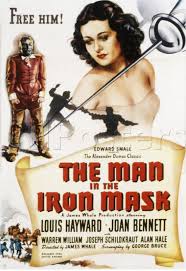
THE MAN IN THE IRON MASK
US, 1939, 110 minutes, Black and white.
Louis Hayward, Joan Bennett, Warren William, Joseph Schildkraut, Alan Hale, Miles Mander, Bert Roach, Montagu Love, Albert Dekker.
Directed by James Whale.
The Man in the Iron Mask is a classic version of the Alexandre Dumas popular story. It shows the four Musketeers in their old age as well as the famous story of the twins born to the king, one ascending the throne as Louis XIV, the other hidden from birth and brought up in secret in Gascony. The development was that Louis XIV was ruthless and his brother Philippe was substituted in his place, Louis being imprisoned in the iron mask.
Warren William is a dashing D'Artagnan. Joan Bennett is Princess Maria Teresa of Spain. Joseph Schildkraut, who had just won an Oscar for best supporting actor in The Story of Emile Zola, is the king’s adviser.
While filmed in black and white, the film is nevertheless quite a spectacle. There is a great deal of action as well as the drama of the intrigue at court.
The film was directed by British director, James Whale, who had made Journey’s End in England and then come to Hollywood where he became a celebrity with his success for Frankenstein. He also directed Bride of Frankenstein as well as the Irene Dunne 1936 version of Show Boat. Whale’s story was portrayed in the film, Gods and Monsters, with Ian McKellen? as James Whale.
1. The film as the classic adventure film? Enjoyably so?
2. The characteristics of the thirties style? Costume melodrama? Ways of acting, characterization? Cardboard or real? Audience expectations of good and bad, heroes and heroines, villains?
3. The importance of the relationship of the story to history and reality? The importance of this in the thirties? In Alexandre Dumas' novels? The nineteenth century tone of the film corresponding to Dumas?
4, How plausible was the plot? The plausibility of romantic ideas of history? Audience response to these fantasies? The importance of the setting of 1638s the births, the political
overtones, France and its future, the King's decisions?
5. The importance of d'Artagnan and the Musketeers? Audience response to them? Their manner of bringing up Philip? The scene of their life in Gascony?
6. The characterization of Fouquet? His initial curiosity? The nature of his rise, his hold of Louis and influence? His conflict with Colbert?
7. The picture of Louis as a profligate? The details of his style, the salt tax, the hanging, his cruelty, his mistress? Louis portrayed as a typical screen villain?
8. The contrast with Maria Teresa? As a focus for the confusion between the twins? Audience hoping that she will understand? The development of her character? The foreign princess, the forced marriage? Her discovery of the truth and her co-operation?
9. The contrast of Philip's character with Louis? His behaviour as king? The daring of his rescue of the Musketeers?
10. The visual impact of the iron mask? Its effect on Philip? The atmosphere of cruelty?
12. Did this justify the same retribution for Louis? Philippe's speech about Louis' forfeiting justice? Louis' imprisonment?
13. The picture of adventure, sword-fighting, rescues, the final chase? Why do audiences enjoy this?
14. The portrayal of diplomacy, the nets and webs, the lack of scruples, the murdering of messengers and stealing of letters etc.?
15. Fouquet, his rise to power, his downfall? How skilful a characterization?
16. The appropriateness of the happy ending? The fairytale adventure and audience response? The fact that the story said that Louis X1V was really his brother?
Published in Movie Reviews
Published in
Movie Reviews
Tagged under
Saturday, 18 September 2021 19:19
Man in the White Suit, The
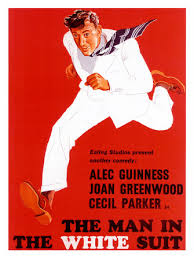
THE MAN IN THE WHITE SUIT
UK, 1951, 85 minutes, Black and white.
Alec Guinness, Joan Greenwood, Cecil Parker, Michael Gough, Ernest Thesiger, Howard Marion-Crawford?, Duncan Lamont.
Directed by Alexander Mackendrick.
The Man in the White Suit has a very strong reputation even after many decades. Nominated for an Oscar for best screenplay and for BAFTA awards for film and screenplay, it is one of the best films that came out of Ealing Studios. During the first half of the 50s Ealing was noted for its comedies with social comment including The Lavender Hill Mob, Passport to Pimlico, The Titfield Thunderbolt. Several of these starred Alec Guinness as well as many of the supporting cast including Joan Greenwood and Cecil Parker. (Guinness and Greenwood had appeared in the Ealing comedy masterpiece, Kind Hearts and Coronets.)
The film takes up the theme of post-war industrial Britain. Guinness portrays a naïve young man who invents a fibre that cannot be destroyed and cannot absorb dirt. This is seen as a boon for the public. However, the industrialists see disaster – as people will not be buying their products. They resort to dirty tactics – and the film has the spectacle of a white suit coming to pieces and dashing its inventor’s hopes.
Alec Guinness had been in films only for four years when this film was released. Appearing in David Lean’s Great Expectations and then as Fagin in his Oliver Twist, Guinness began to make a number of comedies at this time. By 1957, he won the Oscar for The Bridge Over the River Kwai.
The film was directed by Alexander Mackendrick, an American-born director who had great success in the United Kingdom with Whisky Galore, Mandy, The Maggie and The Ladykillers. Back in America he made The Sweet Smell of Success but had a very chequered career afterwards, his last film being the comedy Don’t Make Waves with Tony Curtis and Claudia Cardinale.
1. This is considered a classic British comedy of the fifties, Do you agree? How typical a comedy of the fifties is it? what are its major qualities?
2. Comment on the comedy qualities of the film, the situations, satire, dialogue, characterizations.
3. How did the film rely on an atmosphere of realism, even
though the film was satire? The initial and final commentary
by Cecil Parker? The presentation of the textile industry in the late forties in England? The comment about keeping the story out of the papers etc.?
4. How effective a satire on England was the film on its industry and finance, on capitalism and economics, on inventors, scientists, the workers and the unions, human greed? Where were each of these satirized effectively?
5. The comment on and the insight into the textile merchants and their deals, their budgets, their poor handling of their factories, their seeking for prestige, their trying to buy one another off etc.? What comment and judgement were made on them?
6. How were the workers and the unions presented? The feeling in the presentation of the workers, the satire on their behaviour? The fact that they united in their cause with the employers?
7. The initial presentation of the factory and its competence and incompetence? The use of the convention of the tour and the introduction of the film's themes?
8. The performance of Alec Guinness in the central role? The ordinary little man, his lodgings and friends, his genius, the quality of his experiments, his skill and his mistakes, single-mindedness, the humour of his explosions, the happiness of his success? The irony of success and its effect on him, with the employers, the workers, his girlfriend? The significance of his ultimate failure and everyone laughing at him?
9. How attractive was the heroine? Joan Greenwood's style, a conventional British heroine or more? Her support, her love, her going through the motions of seducing him and testing him? Her final support in his humiliation? The human feeling communicated here?
10. Such minor characters as the landlady and her washing? The people employed in the factories? The accounts people etc.?
11. How necessary was the failure of the cloth? How was England saved? The irony of being saved with the wrong methods and for the wrong reasons?
12. How did the black and white photography, the screenplay contribute to the film? The musical background# especially the symphony of the experiment?
13. What values were chiefly explored in this comedy? Was the film a good example of the British comedy genre?
Published in Movie Reviews
Published in
Movie Reviews
Tagged under
Saturday, 18 September 2021 19:19
Manitou, The
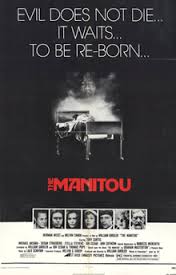
THE MANITOU
US, 1978, 104 minutes, Colour.
Tony Curtis, Michael Ansara, Susan Strasberg, Stella Stevens, Jon Cedar, Ann Sothern, Burgess Meredith, Paul Mantee, Jeanette Nolan, Lurene Tuttle.
Directed by William Girdler.
The Manitou is a supernatural thriller coming five years after The Exorcist and in the middle of a lot of animal terror films following Jaws.
The synopsis has to be read to be believed. Susan Strasberg goes to hospital because she has a tumour on her back. Some think that it is alive, a foetus inside the tumour. However, a number of fortune tellers get involved including Tony Curtis who disbelieves it, Stella Stevens who begins to help and the suggestion is, especially from an expert played by Burgess Meredith, that it is a four-hundred-year-old Indian spirit who wants revenge and is coming alive. This means a journey to South Dakota where Tony Curtis’s fortune teller meets an Indian witchdoctor, Michael Ansara, to perform a rite where the Indian spirit will go back to where it belongs. The question asked at the end is, can the spirit actually be sent back.
The film received fairly negative reviews, many considering the outlandish plot implausible to say the least. However, with its starry cast, its belief in its own preposterous story, it is rather entertaining in an oddball kind of way.
The film was the last directed by William Girdler who began direction in 1972, making a number of blacksploitation films including Abby and Sheba Baby as well as two of the animal menace films, Grizzly and Day of the Animals. (Girdler was killed in a helicopter crash in the Philippines just after the film was completed.)
1. An interesting occult thriller? The tradition of The Exorcist and using its plot line? The popularity of this kind of film? Audience interest in the occult and transcendent powers? As in contemporary America, the background of the American Indian? The horror aspects and audience enjoyment of horror fantasy?
2. The focus of the title and its explanation? The images portrayed during the credits and creation of atmosphere? Possession, magic, the Indian religious background of the story and the exorcism?
3. The use of Panavision, the beauty of San Francisco locations and the way these were presented? Plausible material though unreal? A real world to make the events more credible? The world of magic, superstition, seances? This kind of belief in magic and its connection with Red Indian magic and traditions? The importance of the special effects within this context? Karen and the Manitou on her neck, the whirling scenes of destruction especially the climax? The use of coloured visuals especially for the final illusions? The contribution of the score?
4. The plausibility of the plot? The indication that such things are factual especially with the note at the end about the Japanese boy? The world of medicine with which the film opened, x-rays, doctors' consultations, surgery? The contrast of this world with that of the Indians and their spirits, super-human powers? The growing implausibility with the failed operation and the surgeon slashing himself, Mrs Herz and her behaviour, her elevation, throwing herself down the stairs? The transition to Indian medicine and its performance? The explosions, the deaths, the nature of the illusions, the Manitou of the machines having power through Amelia and Harry's love? How easily can an audience suspend disbelief in such plot lines and special effects?
5. The theme of contemporary technology and its power and lack of power? The super-human and the transcendent, the medicine man and the devil? The seance and its power to summon up spirits? The change at the end with the assertion of the Manitou of technology and its being turned against the medicine man and the devil? even if temporarily? Who has the power?
6. Why such malevolence in contemporary society? The Californian Indians and reincarnation? Why the 20th century and contemporary San Francisco?
7. The introduction to Karen, as a person in herself, her concern about the lump and the revelation of the foetus? Her reliance on Harry and their shared experience at Fisherman's Wharf, the night together, her uneasy sleep and her incantation? her experience of the growth, the operations, her being taken over by the Manitou? The icon-like exercise with power at the end? The satisfying return to reality? Suitable heroine for this plot?
8. Tony Curtis's style as Harry? Seeing him as professional adviser, magician, his use of the cards and his pandering to elderly ladies' whims? The tongue-in-cheek attitude of Harry towards these events? The irony of the girl across the corridor? His relationship with Karen and trying to help her? The power of love? His using of the tarot cards and the indication of death? His alertness to her dreams? His consulting with the doctors and not being able to persuade them? His encounter with Mrs Herz and trying to help her and his being amazed at her death? His consulting Dr Snow and learning about Manitou’s, his visit to John Singing Rock and working with him for the medicine? Continued anxiety, his presence, his involvement with the doctors and with John Singing Rock especially in the illusions? The power of his love to save Karen? How convincing a hero for this kind of film? A professional phoney and yet his ability to bring success to a dangerous situation?
9. The personality of John Singing Rock, as a medicine man, his home, wife? His fee and attitude towards money and tobacco, his knowledge of law? His statements on love as power? Drawing the circle, confronting the Manitou especially in its birth, his failure, the training of the Manitou of the technology through Karen and his winning in the end?
10. The character of Amelia and her friendship with Harry, her husband, the attitude towards magic, the holding of the seance and the visual effects, Karen's aunt and her presence, the appearance of the face, the special effects of the storm? The visit to the professor and his humorous absent-mindedness yet revealing the truth to them? The strengths of these portrayals as giving substance to the film especially the portrait of Professor Snow by Burgess Meredith?
11. The importance of focussing on Harry's clients and what they revealed about him, superstition and magic, Mrs Herz and the complexity of her reaction and her death?
12. The portrait of the doctors as 20th century men involved in technology and surgery, their ignorance, fears, involvement? Dr Hughes and his ambiguous attitudes, victim especially with his arm and hand? Dr McEvoy? and his scepticism?
13. The Manitou itself, its growth, the visuals of its birth, killing, eyes, laughing, control, illusions, summoning the great evil, the spectacular nature of its destruction and the confrontation with Karen? The possibility of its reappearance and reincarnation?
14. The overall effect on an audience of this kind of experience? Enjoyment, learning? The facing of fear fantasies?
Published in Movie Reviews
Published in
Movie Reviews
Tagged under
Saturday, 18 September 2021 19:19
Man of Bronze/ Jim Thorpe-All-American
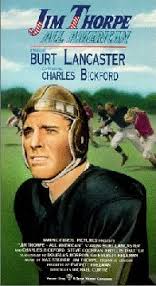
JIM THORPE - ALL-AMERICAN (MAN OF BRONZE)
US, 1951, 107 minutes, Black and white.
Burt Lancaster, Charles Bickford, Steve Cochran, Phyllis Thaxter, Dick Wesson, Jack Bithead, Sonny Chorre.
Directed by Michael Curtiz.
Jim Thorpe – All- American is a biography of a Native American athlete who won many gold medals in track and field at the Stockholm Olympic Games in 1912.
The film traces his biography in the 1940s and 50s style. He grew up in poverty, trained hard in his college days, took jobs to make ends meet. However, he agreed to play semi-professional basketball at one stage of his studies – and this came up against him in Stockholm and he was stripped of his medals and his name stricken from the record. With lobbying, his name and the medals were restored in 1982.
Burt Lancaster, a strong athlete, portrays Thorpe most effectively. Charles Bickford is his coach. Phyllis Thaxter is his girlfriend. A number of Native American Indians have some supporting roles in this film.
After Stockholm, Thorpe became alcoholic, played some Indians in westerns in Hollywood, eventually lived from the payment made for his life story from Warner Bros. He died two years after the film was released.
The film is something of a belated tribute to one of America’s best athletes. It was directed by Michael Curtiz, Hungarian director who was very successful in Hollywood at Warner Bros in the 1930s, won an Oscar for Casablanca, made a number of musicals and comedies during the 1950s and moved into spectacles with The Egyptian in 1954.
1. The appeal of the film? sport? For all audiences?
2. The film as an example of Warner Brothers production in the early fifties? Black and white photography, Max Steiner's score?
3. The title and emphasis on Jim Thorpe? The American title an All American and the particular emphasis on this title?
4. Audience interest and sympathy in biography? The ups and downs of life, crises? How realistic a biography did this show? Facing the good and bad in life?
5. The background of racial issues in the film? The ups and downs of Thorpe's life becoming a race questioning? his feelings about this?
6. The importance of the opening with the boys' school? discipline, a sense of freedom, listening to his father's lecture? his bracing himself to leave?
7. The similarities when he was a young man? His arrival at the college with a chip on his shoulder, his sullenness and resentment? The encounter with the students and the football? His pushing himself to study? His running giving him a atmosphere of freedom?
8. The importance of the encounter with Doc? Doc's importance and pointing a moral about life? Encouraging him in sport? The change in his life and outlook?
9. The film's portrayal of Thorpe's talent? His natural ability at sport, his success and exhilaration? His energy in games and understanding them? The realisation that he had a purpose in life in being an athlete?
10. The importance of his love for Margaret? the genuineness of their love? The difficulty of the race question with Margaret at the school? Her going and returning? The importance of their marriage and what they meant to each other? The importance of the son and Jim Thorpe's trying to make hie son like him? How crushing the death? How crushing Margaret's re-marriage and separation? Was this credibly presented?
11. Thorpe's achievement at the Olympic Games and the way that he was visualised? His professional life, crisis about the trophies and his taking money, his bitterness about racism? His playing football yet going downhill? The reason for his self-centredness and grudges? The visit of his friends from college?
12. Scraping the bottom? drink, self-respect? playing mean games and physical collapse?
13. How did he come up again? The encounter with Doc at the Olympics? Breaking through his bitterness, the encounter with the children?
14. The finale with the dinner, the tribute to him? The hope for some kind of achievement? The film's realistic outlook on his life? Too optimistic for this kind of human achievement?
Published in Movie Reviews
Published in
Movie Reviews
Tagged under
Saturday, 18 September 2021 19:19
Man on a Tightrope
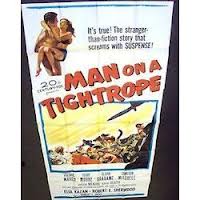
MAN ON A TIGHTROPE
US, 1953, 105 minutes, Black and white.
Fredric March, Terry Moore, Gloria Grahame, Cameron Mitchell, Adolphe Menjou, Robert Beatty, Richard Boone.
Directed by Elia Kazan.
Man on a Tightrope is one of the lesser-known works of Elia Kazan who won Oscars for Gentleman’s Agreement and for On the Waterfront (made after this film). He made a number of striking films including A Tree Grows in Brooklyn, Pinky, Splendour in the Grass, A Face in the Crowd. He also made the autobiographical America America.
Commentators think that the Mc Carthyism of the 1950s, the anticommunist diatribes and the demands for American loyalty meant that this more subtle critique of communist Europe did not succeed as might have been hoped.
The film has a very strong cast led by Fredric March as the owner of a circus who finds his performance under critique by the government and decides to flee, with his family, wife and daughter, Gloria Grahame and Terry Moore, to the West. He decides that the escape attempt will be in full daylight – in performance.
Adolphe Menjou is effective as a communist official.
The film indicates the kind of wariness of communism during the Cold War years – but is much more developed in its analysis and critique than the usual fare.
1. The implications of the title? A circus, the symbolism of a tightrope, the situation of Cornik, the possibility of a fall, danger of death? The tone of this for the film?
2. Was it evident that this film was made in the fifties? Would a film on a similar topic be made similarly now - the presentation of Communistic countries? The atmosphere and tone? how did the film reflect the America of the period? Did this take away from the impact of the film?
3. How good was this film as an escape adventure? Did the story and the people seem real? Situations generating genuine tension?
4. The presentation of the circus itself and its use as an allegory for the world? A circus a part of the old times, its place in the new, authorities' criticism about the content of the circus, the possible political function? The significance of the trap putting the circus in the ditch in the beginning? Yet people's response to the circus is the same? Officials enjoying the circus, the soldiers distracted to watch it? The circus as a perennial value? Entertainment enjoyed as a perennial value? How well was this illustrated at the end? How did the circus atmosphere provide the film's happiness and sadness, clowns, masks, feats of daring etc?
5. How interesting a character was Cornik? The circus heritage, his mother, his leading his troupe, his ignorance yet his initiative? His wanting to escape and be free, the clash between this and the political emphasis of Cornik? His relationship with his daughter, with his wife and her infidelity? His capacity for handling people? His ignorance and fear? His shrewd behaviour towards the authorities? what were the main reasons for his deciding to escape? The goal of freedom? The deal with the dwarf, the rival circus master? His suspicions? The portrait of the risks and Cornik’s response to them? His death, waving others? What kind of man was he?
6. How conventional were Joe and Teresa as hero and heroine? How conventional were their parts? Their role in the plots? Was there any insight into love, freedoms, refugees from? Cornik and the American background? The interrelationship of the two and with their father?
7. Zama as a conventional character? Her role in the circus? Her relationship with Teresa and with Cornik? the change of heart, her change of heart at the end?
8. The portrait of the Communists? How genuine and sympathetic? Fesker and his insight into Cornik’s behaviour and his wanting them to pursue him quietly? The fanatic Korfta and his shooting of Cornik? The younger officials trying to be superior over the older ones? How much suspense did this give?
9. The importance of the prison sequences? Torture and suspense? The abuse of human freedom etc?
10. Many were killed during the escape? Was the killing and the death equal to the experience of freedom?
11. The significance of the final march to freedom? The paralleling with the initial procession and being forced into a ditch? The proud aloofness of the mother? The animals and the clowns, the performance to freedom? Cornik dying? The music? What did this communicate about the people and freedom?
12. How was the film a picture of the 20th century world?
Published in Movie Reviews
Published in
Movie Reviews
Tagged under
Saturday, 18 September 2021 19:19
Man on the Flying Trapeze, The
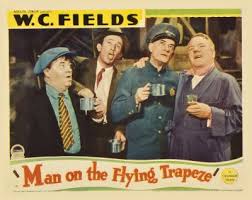
THE MAN ON THE FLYING TRAPEZE
US, 1935, 65 minutes, Black and white.
W.C. Fields, Mary Brian, Kathleen Howard, Grady Sutton, Walter Brennan.
Directed by Clyde Bruckman.
The Man on the Flying Trapeze is only brief but is considered one of W.C. Fields’ best films. He contributed to the storyline.
He plays an ordinary working man who is harassed by his wife (Kathleen Howard) and put upon by his mother-in-law. He also has a difficult boss. One day he decides to take the afternoon off and has a series of adventures – especially since he told his boss that he was going to his mother-in-law’s funeral. Interactions with a policeman, a chauffeur, chasing a tyre, getting hit by the body of a wrestler from the ring lead to all kinds of difficulties. However, he finishes up getting admiration from them all (**??) , a raise – and is able to go on a holiday.
W.C. Fields had made an enormous impact in films in the 1930s. The film was directed by Clyde Bruckman, a prolific writer who, unfortunately, was a severe alcoholic who finally committed suicide in 1955. However, he contributed to a number of films of Buster Keaton and Harold Lloyd.
1. Entertaining W.C.Fields comedy? The quality and type of the comedy? The nature of its appeal? To what audience? Exasperated men identifying with Fields?
2. The conventions of the comedy? Artificial situations, Fields' dialogue, written by himself? The American household, police, work?
3. Black and white photography, music, locations? Unreal, real?
4. How possible was the plot? Did this matter?
5. Fields character as the exasperated American husband, his joining with the robbers, his going to the police and his being arrested, the court sequence? Background of work being out of work, harassed by his wife, devoted daughter? His being vindicated by his daughter and the happy ending? The predicaments, the exasperation, the vindication?
6. How well drawn for the purpose of comedy were the minor characters; the robbers and their singing, the police, the judge, the wife and her exasperation and her haughtiness, the in-laws, the brother in law and his being pampered, the daughter and her devotion?
7. The hero in the sequence in persuading him to go down to face the robbers, joining in the singing, the experience of the police station, his skill at his work and memory, his being out of work and at home, his daughter negotiating the improvement, final ride in the car, the scenes of his brother in-law being attacked by the rest of the family?
9. What themes of American life were presented via comedy parody and satire?
Published in Movie Reviews
Published in
Movie Reviews
Tagged under
Saturday, 18 September 2021 19:19
Mannen Pa Taket/ Man on the Roof
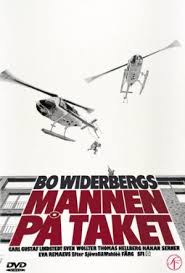
MANNEN PA TAKET (MAN ON THE ROOF)
Sweden, 1976, 110 minutes, Colour.
Carl- Gustaf Lindstedt, Sven Wollter, Thomas Hellberg, Ingvar Hirdwall.
Directed by Bo Widerberg.
Man on the Roof is considered one of the best of Swedish police thrillers. It is based on a novel by the prolific writers Maj Sjowall and Per Wahloo. Their main character is an inspector called Martin Beck. Here he is portrayed by Swedish comedian Carl-Gustav? Lindstedt.
The Martin Beck character was portrayed in a number of other films but especially during the 1990s in a series for Swedish television.
Another novel by the writers was filmed in the United States in 1974 by Stuart Rosenberg and Walter Matthau and Bruce Dern.
The film is almost semi-documentary in style, getting its impact from characterisation and plot development rather than the American-style car chase and tough investigation. The interest is on the situation, an angry man going onto the roof of a building to avenge his wife who died in police custody, under the care of the police lieutenant, Nyman, who is murdered at the opening of the film.
The film has intelligent writing, has strong characterisations as well as insight into the police thrillers – and it is interesting to make comparisons with the 1970s American thrillers, especially the Dirty Harry and the Popeye Doyle, French Connection series.
1. The quality of this thriller, enjoyment value, social and personal themes, crime and the modern city? Modern madness and crime?
2. The film was based on a popular Swedish novel and popular Swedish police characters. Was this evident from their treatment in the film? The particularly Swedish contribution of theme, plot, characterization, social environment? The impact for a Swedish audience, non-Swedish audience?
3. The importance of the city environment, the visualizing of Stockholm, the streets, the buildings? The police within this context? Ordinary people and the eruption of crime and the sniper Into their midst? Ordinary rescue within this context?
4. How authentic was the plot, the characterization of the police and their work? The film's concentration on police individuals, their work together, the role of the police force In a city, detective work, dangers etc.? The particular events In which they were involved as authentic? The less than sensational treatment? Documentary overtones? The possibility of an audience identifying with the police and the reality of the situations?
5. The focus on the detective* and audiences liking them and identifying with them? Ordinary, age, skill, family sequences, mutual loyalties, abilities in their work? The bonds between them? The focus on Beck as a character in himself, his quiet and practical wisdom, his heroics? An interesting detective? In comparison with the others?
6. The dramatic impact of the opening, the toughness and the violence? Sympathy for the murdered man? The horror of the brutality and gore? His being hospitalized? The transition to his widow? The gradual unfolding of the truth and the lessening of sympathy for him? How important was the initial sympathy for audience response to the murderer, to the police work?
7. The Chief of Police who was murdered and the comparison with Hult? Their work together, brutality even to killing people, the cover-up? The kind of police mania which is so brutal and has cover-ups? Hult as a person, his gradual involvement in the case, his sense of responsibility and involvement in the rescue?
8. Kollberg and his involvement? His heroics at the end? The up and coming young lad-policeman compared with Beck?
9. The various pieces of the plot about Nyman and the gradual revelation of the truth? Throwing light on his violent death? The police and the various interviews to find out what had happened? The searching out of the files to find why he was murdered? How convincing were these aspects of police work? The visit to the parents? The realization that he was the murderer?
10. The focus on the sniper, the visualizing of the sniper and his killing ordinary people in ordinary streets doing ordinary things?
11. The link between as the murderer and as the sniper? How credible was this kind of police work? As providing a strategy for Beck to cope with the situation? The devices of the helicopter, the police being lowered? The deaths of the police? The ordinary men involved (and the man without a gun licence?), the ordinary heroism of the people involved? Their skill? The requirements of extraordinary heroism, even of Beck?
12. Now well portrayed was the character of Eriksen, the deep hurt with the death of his wife, his police work and knowledge, the motivations and the growing madness, the murder of Nyman, his erratic behaviour? The motivation for his sniping? The sniper as a symbol of the person driven mad by the ills of society and taking his revenge?
13. How accurate was the social observation? Ordinary observation, points being made?
14. How accurate was the psychological observation of the sniper, the police and their work, brutal police chiefs and their assistants?
15. How well did the film blend the thriller ingredients, the police genre, social and psychological comment? A satisfying film?
Published in Movie Reviews
Published in
Movie Reviews
Tagged under